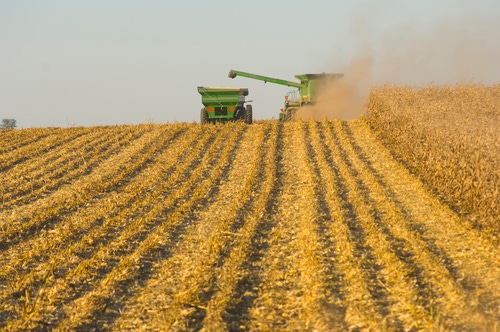March 15, 2015

What’s the secret to growing 100 bushel soybeans and 300+ bushel corn in the Dakotas?
High plant populations, lots of fertilizer and “no boat.”
That’s what I gleaned from the recent Soy100 conference at South Dakota State University.
Scott McKee, Alcester, S.D., talked about what he did to produce 103 bushels of soybeans per acre to win the 2014 South Dakota Soybean Yield Contest.
Frank Kralicek, Yankton, S.D., answered questions about how he produced 318 bushel corn last year in the South Dakota Corn Show Plot.
Both yields were independently verified.

The secret to yield success? High plant populations, lots of fertilizer and "no boat"
McKee double-planted the field where he pulled a 103-bushel per acre yield for the soybean contest. He ended up a stand of about 225,000 plants per acre in 15-inch rows.
The record setting yields both came from fields where lots of hog or cattle manure had been applied in the past.
The fact that high levels of fertilizer are needed for 300 bushel per acre corn is no surprise. But soybeans is another story.
We used to think that soybeans could fix all the N they needed themselves, said Cheryl Reese, SDSU research agronomist. But this only works for soybeans that yield 40-50 bushels per acre. Additional bushels have to come from soil mineralization or applied fertilizer.
To produce 60-100 bushels per acre, soybeans can only make 40-50% of the N that is needed, Reese said.
The tricky part is that you can’t apply all extra N for soybeans before planting because then the soybeans won’t produce the nodules they need to fix N themselves. Also, there’s a problem with losing N if it rains a lot.
Both Kralicek and McKee said they soil test regularly so they know how much fertilizer they need to apply each year. Kralicek takes a half dozen tissue tests in his corn and soybeans during the growing season. Lots of times, the soil test will indicate that there are enough nutrients in the soil, but plants aren’t taking it up. He’s foliar applies or sidedresses fertilizer to correct deficiencies..
Both men said using pre-emergent herbicides are important to achieving high yields. In their experience, post emergent herbicides don’t give them absolutely clean fields early in the growing season.
They scout fields themselves and they do it constantly all summer long. McKee said he carries a magnifying glass with him during the growing season. Kralicek says he is in his fields every week or so. When spraying, he’ll stop the tractor and just walk around the field. Trips to his mother’s for Sunday dinner, turn into field scouting trips.
Some other interesting things about how these farmers approach growing corn and soybeans:
* Kralicek doesn’t plant the same soybean variety on anymore than 5-10% of acres. For corn, he doesn’t go over 20% of his acres to one hybrid, no matter how good it was the previous year.
* Good soil drainage is a must. Kralicek said he’s seen some marked improvements in yields where he has tiled.
* Variable rate seeding is different for soybeans than corn. For corn, these farmers increase plant populations on their better ground and cut back on your tougher ground. They do the opposite for soybeans – a higher seeding rate may work better on your poorer soils. McKee said it seems more closely spaces soybeans push through crusts and other tough soil conditions better than widely spaced beans.
McKee and Kralicek said it takes a lot of work and time produce 100 bushel soybeans and 300 bushel corn. Upon hearing that Kralicek – who lives near the Lewis and Clark Recreation Area, a popular fishing and vacation spot on the Missouri River -- does his own soil testing, tissue sampling and will spray a field three to six times a season, one person in the Soy100 audience piped up and asked, “So you must not own a boat?�”
“No,” Kralick says, shaking his head, “I don’t own a boat.”
You May Also Like




